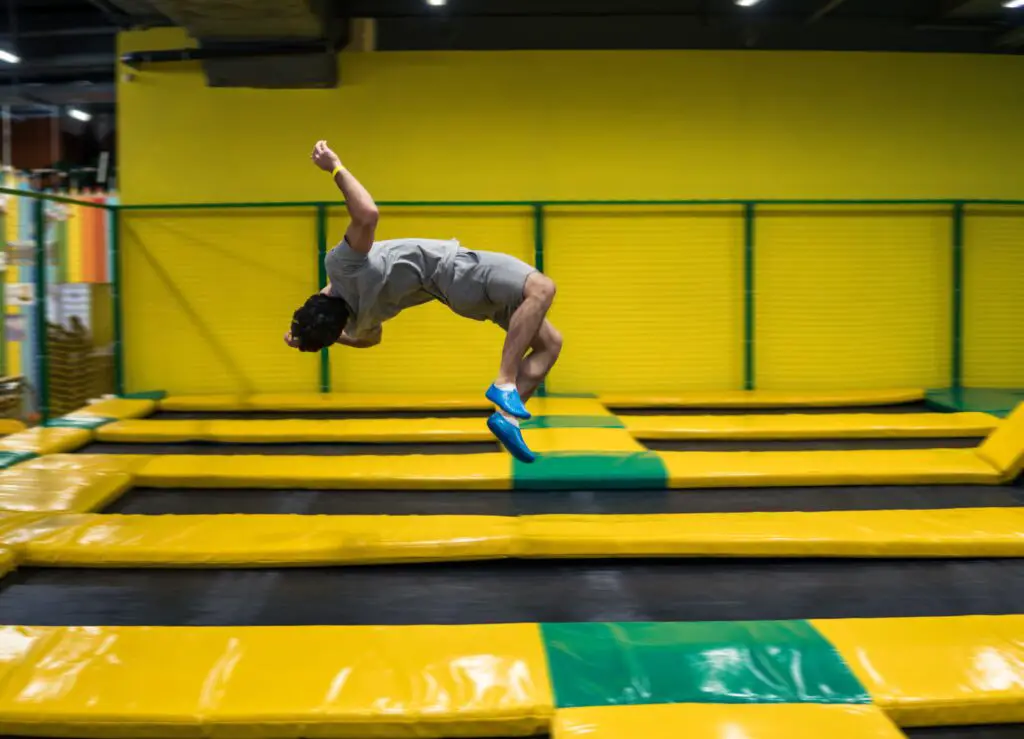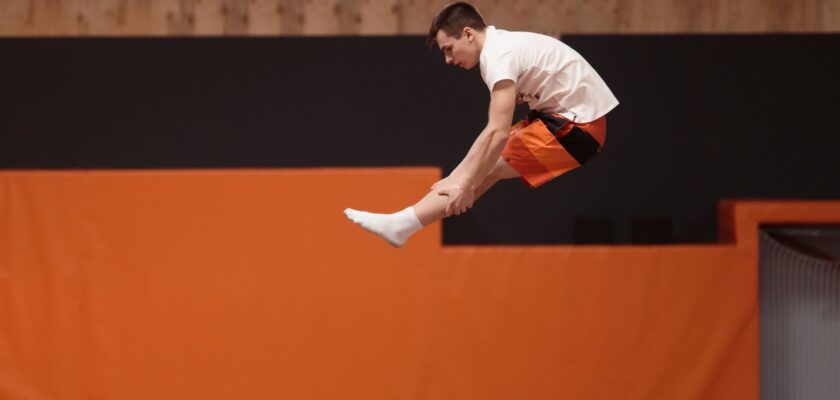Trampoline gymnastics is one of the lesser-known disciplines in the sports world. However, it is quite familiar to many as a circus attraction. What few people know is that there is even an International Federation dedicated to this sport. Let’s explore it! Stick around to find out all about trampoline gymnastics!
Open your Betano account and get up to 1,000 reais in bonuses.
Payments via PIX, live games and super odds!
Click here to open your account!

All about Acrobatic Gymnastics: history
Trampoline gymnastics has its roots in Greece, but its modern version was developed in the United States in 1934.
The idea of using the trampoline for physical exercise was inspired by the trampoline used in circuses;
Gymnast George Nissen, together with fellow American gymnast and artist Larry Griswold, created the trampoline by adapting the nets used in circus shows.
Nissen and Griswold began selling the equipment and also distributed it free of charge to universities with the aim of increasing its popularity.
The equipment has attracted attention because of the exercises it makes possible. The trampoline has also been used to train astronauts;
Read to the end and find out all about trampoline gymnastics!
During and after the Second World War, it was used in the military training of paratroopers and pilots, until it was replaced by simulators.
Over time, trampoline gymnastics gained followers and stopped being used only for military training, becoming a sport in its own right;
In 1948, the first trampoline gymnastics championships were held in the USA. In 1955, the sport was included in the Pan American Games in Mexico.
In 1964, the first world championships were held in London, and in the same year the International Trampoline Federation was created.
In 1971, George Nissen and Larry Griswold founded the US Trampoline and Tumbling Association. Trampoline gymnastics arrived in Brazil in 1975.
Although the new sport was scheduled to be included in the Moscow Olympics in 1980, an accident involving a gymnast who became quadriplegic after a fall postponed the debut of trampolining at the Olympic Games.
Read to the end and find out all about trampoline gymnastics!
In 1990, Brazil took part in the World Trampoline Gymnastics Championships in Germany for the first time.
Finally, in 2000, trampoline gymnastics made its debut at the Sydney Olympic Games, with separate competitions for men and women;
Since then, the number of events (two) has remained the same. Since their inclusion in the Olympics, athletes from the People’s Republic of China have won 14 of the 36 medals handed out, including four gold;
Canadian Rosie MacLennan is the only athlete to successfully defend an Olympic title in trampoline gymnastics, winning gold at the Rio Games in 2016 after being champion at London 2012.
Read to the end and find out all about trampoline gymnastics!
All about Trampoline Gymnastics: how does it work?
The two individual competitions in trampoline gymnastics (men’s and women’s) consist of athletes performing jumps that can exceed eight meters in height on a trampoline;
During competitions, the athletes perform routines with ten elements, which are evaluated based on difficulty, execution and flight time. This sport is extremely technical and requires absolute precision.
The equipment used in this sport is the trampoline. Its structure consists of an elastic support, covered by a net with a thickness of six millimeters;
The trampoline’s total area is 5.05 meters long by 2.91 meters wide, and the net is positioned at a height of 1.55 meters;
The dimensions of the net are 4.28 meters long and 2.14 meters wide. The jumping zone, inside this net, is much smaller than the total area, measuring 2.15 meters long by 1.08 meters wide.
This trampoline is a rectangular canvas made of synthetic fabric, used to perform a series of spins, jumps and somersaults.
The trampoline is attached to a structure with steel springs, which provides the necessary thrust for the athletes to climb;
Read to the end and find out all about trampoline gymnastics!
All about Trampoline Gymnastics: types of events
In the world trampoline gymnastics tournaments, four types of event are contested:
- Individual Trampoline;
- Synchronized Trampoline;
- Double Mini-Trampoline;
- Tumbling.
The competitions are assessed by eight judges, a central judge, two judges who assess the degree of difficulty, and five judges who assess the execution. Each stunt receives a maximum mark, with deductions made for flaws in the execution of the movements.
At the Olympic Games, trampoline gymnastics is only represented in the individual trampoline event.
Individual Trampoline
The gymnast jumps on the trampoline and performs a series of techniques specific to the sport.
Synchronized Trampoline
Two gymnasts jump simultaneously, each on their own trampoline, performing the required techniques. The trampolines are positioned parallel to each other with a distance of 2 meters between them.
Double Mini-Trampoline
The gymnast runs up to the trampoline, jumps on it and then performs the required techniques, landing off the apparatus at the end.
Tumbling
The gymnast runs on a 26-meter track to the trampoline, jumps and performs the techniques required of the sport.
Read to the end and find out all about trampoline gymnastics!
All about Trampoline Gymnastics: types of acrobatics
In trampoline gymnastics, there are various stunts that athletes can perform. Get to know them all:
Pike Jump
A jump in which the body forms a right angle, with the legs stretched forward and the arms reaching the feet.
Straddle Jump
Similar to the star heel, but with the legs spread out to the sides.
Tuck Jump
A jump in which the knees are pulled towards the chest, with the arms wrapping around the legs.
Front Tuck/Pike/Straight Somersault
A complete forward twist in the air, which can be performed in a grouped, straight or extended position.
Read to the end and find out all about trampoline gymnastics!
Back Tuck/Pike/Straight Somersault
A complete backward twist in the air, which can also be performed in a grouped, carpado or extended position.
Double Somersault
Two complete spins in the air. It can be a double forward or backward somersault, in different positions (grouped, carpado or extended).
Triple Somersault
Three complete spins in the air, which can also be forward or backward and in different positions.
Barani
A forward somersault combined with a half pirouette (180 degrees).
Full Twist
A backward somersault with a full pirouette (360 degrees).
Read to the end and find out all about trampoline gymnastics!
DDouble Twist
A jump with two full spins and a full pirouette.
Triple Twist
A jump with three complete spins and one complete pirouette.
Rudy
A somersault forward with one and a half pirouettes (540 degrees).
Randolph
A forward somersault with two and a half pirouettes (900 degrees).
Read to the end and find out all about trampoline gymnastics!
All about Trampoline Gymnastics: rules and regulations
In a trampoline gymnastics competition, there are several rules that athletes must follow. These rules guarantee the fairness and safety of the competition, as well as ensuring that performances are evaluated consistently.
Competition format
- Categories: competitions usually have separate categories for men and women.
- Stages: a typical competition can include qualifiers, semi-finals and finals.
Routines
- Number of elements: each routine must contain exactly 10 elements.
- Variety of movements: athletes must demonstrate a variety of movements, including somersaults and pirouettes.
- Flying time: the time the athlete stays in the air is an important factor in scoring.
Evaluation
The performances are assessed by a panel of eight judges:
- Central Judge: supervises the competition and ensures compliance with the rules.
- Difficulty Judges (2): assess the degree of difficulty of the movements.
- Execution Judges (5): evaluate the technique, form and execution of movements.
- Scoring: each element is scored based on its difficulty, execution and flight time. There are deductions for errors such as landings outside the jump zone or imbalances.
- Final score: the final score is the sum of the difficulty, execution and flight time scores, minus any deductions for failures.
Penalties and deductions
- Execution errors: points lost due to technical errors, such as flaws in form, unstable landings or incomplete movements.
- Landing: points deducted if the athlete does not land in the designated area.
- Interruption: if the routine is interrupted, the athlete may receive deductions or even be disqualified, depending on the severity of the interruption.
Security
Supervision: the presence of supervisors or coaches is mandatory to ensure the safety of the athletes.
Protective equipment: protective pads and other safety equipment should be in use to minimize the risk of injury.
Athlete conduct
Punctuality: athletes must be ready to compete according to schedule.
Behavior: respectful and professional conduct must be maintained at all stages of the competition.
What did you think of learning all about trampoline gymnastics? Take the opportunity to learn about other types of gymnastics:



